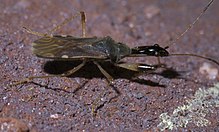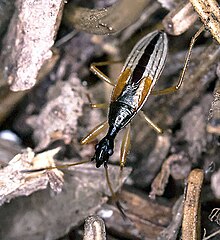
Hibernation is a state of minimal activity and metabolic depression undergone by some animal species. Hibernation is a seasonal heterothermy characterized by low body-temperature, slow breathing and heart-rate, and low metabolic rate. It is most commonly used to pass through winter months – called overwintering.

Dormancy is a period in an organism's life cycle when growth, development, and physical activity are temporarily stopped. This minimizes metabolic activity and therefore helps an organism to conserve energy. Dormancy tends to be closely associated with environmental conditions. Organisms can synchronize entry to a dormant phase with their environment through predictive or consequential means. Predictive dormancy occurs when an organism enters a dormant phase before the onset of adverse conditions. For example, photoperiod and decreasing temperature are used by many plants to predict the onset of winter. Consequential dormancy occurs when organisms enter a dormant phase after adverse conditions have arisen. This is commonly found in areas with an unpredictable climate. While very sudden changes in conditions may lead to a high mortality rate among animals relying on consequential dormancy, its use can be advantageous, as organisms remain active longer and are therefore able to make greater use of available resources.

Richardson's ground squirrel, also known as the dakrat or flickertail, is a North American ground squirrel in the genus Urocitellus. Like a number of other ground squirrels, they are sometimes called prairie dogs or gophers, though the latter name belongs more strictly to the pocket gophers of family Geomyidae, and the former to members of the genus Cynomys.

The boxelder bug, also called box bug, maple bug or, inaccurately, box beetle, is a species of true bug native to eastern North America. The western boxelder bug Boisea rubrolineata is a relative of this species and is native to western North America. Boxelder bugs are found primarily on boxelder trees, as well as on maple and ash trees.

The hazel dormouse or common dormouse is a small dormouse species native to Europe and the only living species in the genus Muscardinus.

The thirteen-lined ground squirrel, also known as the striped gopher, leopard ground squirrel, and squinny, is a ground squirrel that is widely distributed over grasslands and prairies of North America.

The meadow jumping mouse is the most widely distributed mouse in the family Zapodidae. Its range extends from the Atlantic coast in the east to the Great Plains west, and from the arctic tree lines in Canada and Alaska to the north, and Georgia, Alabama, Arizona, and New Mexico to the south. In mid-2014, the New Mexico subspecies of the meadow jumping mouse, Zapus hudsonius luteus, was listed as an endangered species under the federal Endangered Species Act.

Myodochini is a tribe of dirt-colored seed bugs in the family Rhyparochromidae. There are more than 80 genera and 370 described species in Myodochini.

Neopamera is a genus of dirt-colored seed bugs in the family Rhyparochromidae. There are about 16 described species in Neopamera.

Gelastocoris oculatus, the big-eyed toad bug, is a species of toad bug in the family Gelastocoridae. It is found in Central America and North America. Due to their coloration they can be difficult to find. Females lay their eggs under rocks or in sand or mud and both the larva and adults are carnivorous: feeding on other insects along the shorelines.

Pnirontis is a genus of assassin bugs in the family Reduviidae. There are more than 30 described species in Pnirontis.

Myodocha is a genus of long-necked seed bugs in the family Rhyparochromidae. There are about 10 described species in Myodocha.
Myodocha annulicornis, the banded long-necked seed bug, is a species of dirt-colored seed bug in the family Rhyparochromidae. It is found in North America.

Melanopleurus belfragei, the redcoat seed bug, is a species of seed bug in the family Lygaeidae. It is found in Central America and North America.
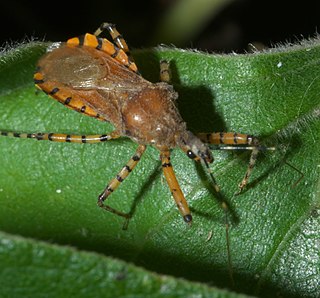
Pselliopus barberi is a species of assassin bug in the family Reduviidae. It is found in North America.
Chalcodermus serripes, the mimosa green-seed weevil, is a species of true weevil in the beetle family Curculionidae. It is found in North America.
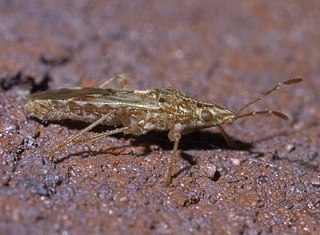
Belonochilus is a genus of seed bugs in the family Lygaeidae. There is one described species in Belonochilus, B. numenius, the sycamore seed bug, making it a monotypic genus.
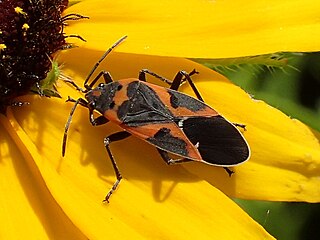
Lygaeus kalmii, known as the small milkweed bug or common milkweed bug, is a species of seed bug in the family Lygaeidae. It is found in Central and North America.
Hydrochara soror is a species of water scavenger beetle in the family Hydrophilidae. It is found in North America. The diet is composed mainly of other aquatic arthropods, though they've been known to consume plant matter as well. They're primarily nocturnal, but are sometimes active by day and do not hibernate.
Myodocha longicollis is a species of long-necked seed bug found in Central and South America
